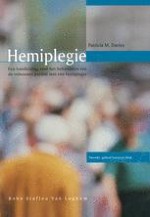Gepubliceerd in:
2001 | OriginalPaper | Hoofdstuk
2. Normaal bewegingsverloop en evenwichtsreacties
Abstract
De behandeling van patiënten met een hemiplegie is een proces van onderwijzen en leren. De therapeut onderwijst, de patiënt leert. Voor het onderwijzen is het belangrijk dat de onderwijzer zijn vakgebied grondig beheerst. In dit geval, waar het gaat om het aanleren van bewegingen en reacties, moet de therapeut precies weten hoe mensen normaal bewegen en reageren. Men moet echter bedenken dat ‘acties kenmerkend uit twee componenten bestaan: een mentale component en een lichamelijke component’ en deze twee hangen nauw samen, omdat ‘de lichaamsbewegingen in onze acties worden veroorzaakt door onze intenties’ (Searle). Wanneer iemand besluit een plan in actie om te zetten heeft hij de intentie te handelen en ‘de organisatie van willekeurige actie, vanaf de intentie tot aan de uitvoering, is afhankelijk van het soort willekeurig gedrag dat die persoon wil uitdrukken’ (Roland 1993). Verwijzend naar verschillende intentieniveaus legt Woodworth (1899) uit dat ‘wanneer ik willekeurig begin te wandelen, is het niet mijn intentie om mijn benen op een bepaalde manier te bewegen, maar is het mijn wens om naar een bepaalde plaats te gaan’, en dat ‘ik niet kan beschrijven welke bewegingen mijn armen en benen gaan maken, maar ik kan aangeven welk resultaat ik bedoel te bereiken’. Er zal dus altijd enige variatie zijn in de manier waarop bewegingen worden uitgevoerd, afhankelijk van de omringende omstandigheden en de persoon die beweegt. ‘In alle gevallen waarin motorisch initiatief of motorische aanpassing vereist is, is er een bepaalde afstemming van de bewegingen op een activiteit die plaatsvindt’ (Bernstein 1996). Bovendien veranderen de lichaamsbewegingen niet alleen onder invloed van de aard van de activiteit en de omgeving, ook anatomische verschillen speien een rol. Verwijzend naar de invloed van iemands constitutie op de manier waarop hij of zij beweegt, verklaart Klein-Vogelbach (1990) dat ‘afwijkingen van de hypothetische norm in de lengte, breedte, diepte en gewicht van bepaalde lichaamsdelen het motorische gedrag van die persoon op een voorspelbare manier veranderen, vooral wanneer de lengteas van het lichaam afbuigt.’
